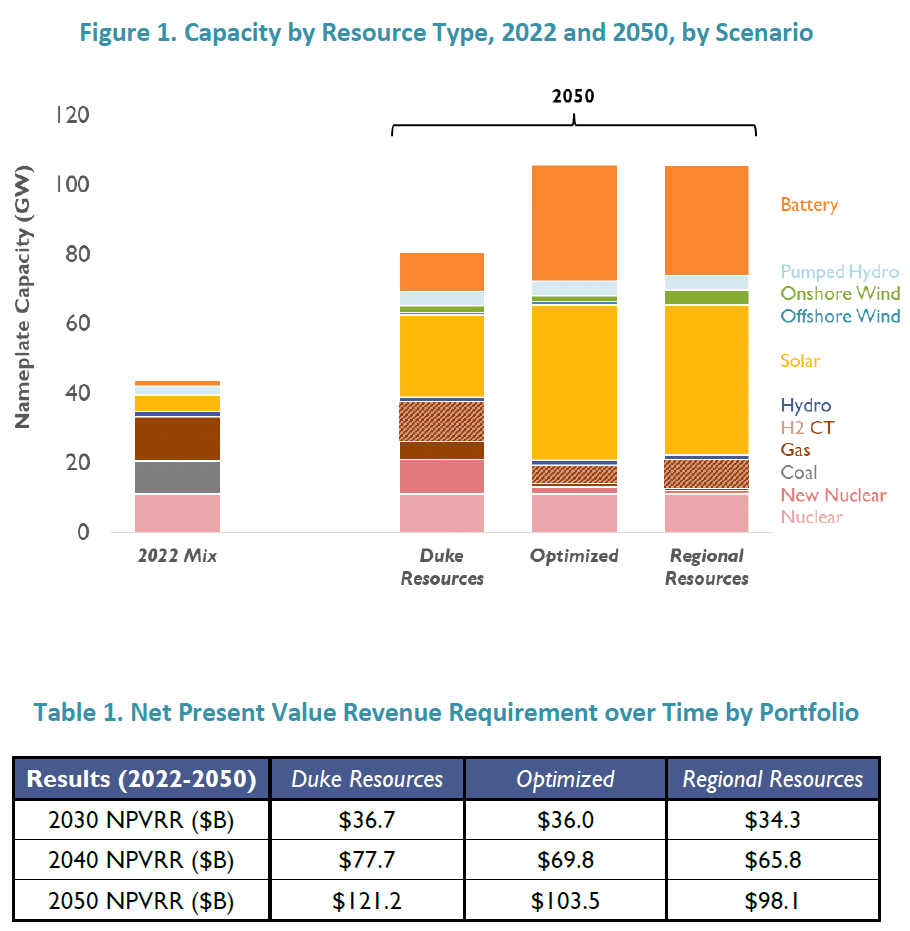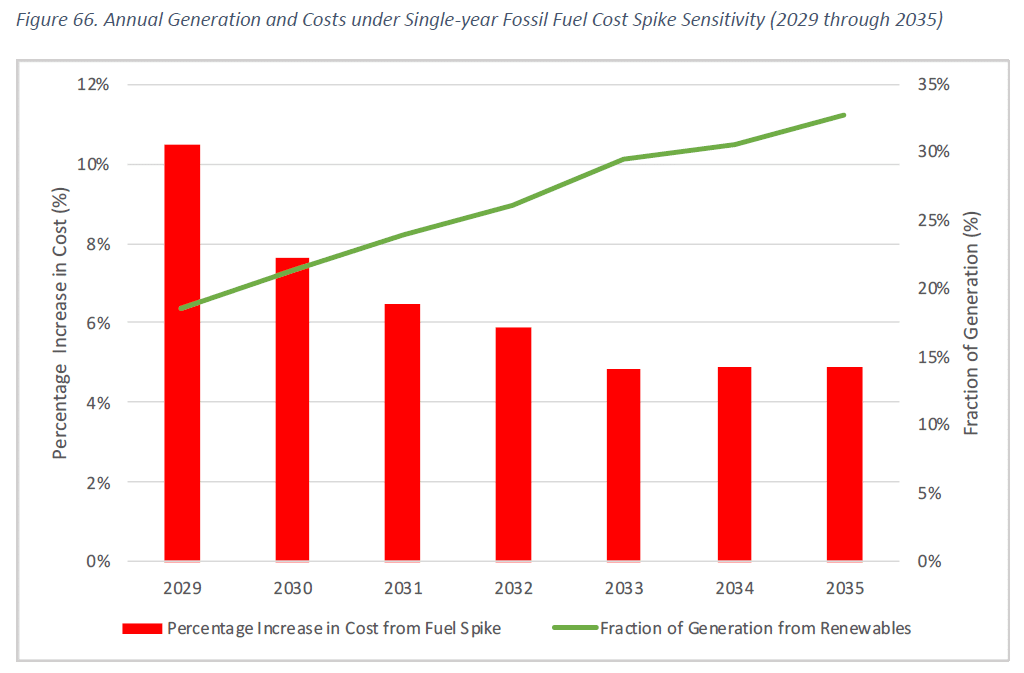The North Carolina Utilities Commission (NCUC) is in the midst of a year-long process to develop a Carbon Plan for the state of North Carolina as prescribed by House Bill 951, which passed in 2021. The NCUC has until the end of 2022 to finalize the state’s Carbon Plan, which will then be updated every two years. HB 951 set carbon reduction targets for large electric utilities, essentially Duke Energy’s two utilities that operate in the state, at a 70% reduction below 2005 levels by 2030 and net zero by 2050.
In May of this year, Duke Energy filed its proposed Carbon Plan. Duke asked the NCUC to approve its plan as-is, but part of the process also includes public review, town halls, and hearing from intervenors. Now is the time for the NCUC to hear from a variety of intervenors, including us at the Southern Alliance for Clean Energy. We’re an intervenor along with the National Resources Defense Council (NRDC) and Sierra Club, who are together represented by the Southern Environmental Law Center (SELC).
SACE and co-intervenors, along with the North Carolina Sustainability Energy Association (NCSEA), filed three reports with the NCUC for their consideration as they develop the Carbon Plan. These reports cover three critical topics: a clean energy plan, how critical transmission is to the carbon plan, and the potential rate impacts of Duke’s proposed carbon plan.
Below I’ll go over those three reports, and why they are important for the NCUC to consider. If you want to learn more about what other intervenors filed, see a great tweet thread from North Carolina energy lawyer, Christina Cress.
A thread summarizing Carbon Plan comments filed by intervenors. This thread is to relay info without editorialization. I’m NOT taking a position–good, bad, or indifferent–re: arguments raised by other intervenors.
— Christina Cress (@cress_cd) July 17, 2022
A Clean Energy Carbon Plan
The main part of a Carbon Plan as described in HB 951 is a utility resource plan that achieves the carbon reduction targets. That is why our coalition of organizations hired an independent consultant (Synapse Energy Economices) to model a resource plan using the same modeling software that Duke uses to develop its resource plans. Some key highlights from the coal plan are below and dive into the full report from Synapse for all the details and methods.
- The coalition plan includes the Optimized and Regional Resources scenarios, both of which are lower cost than Duke’s proposed plan. The costs range from 2-7% less than Duke’s by 2030, and 15-19% less by 2050. That’s a savings of $700 million – $2.4 billion for ratepayers by 2030, with even more savings further out.
- Our plan avoids risky investments in new gas power plants and relies less on unproven, uncertain technologies like small modular nuclear reactors and combusting hydrogen at gas power plants.
- Our plan has Duke invest more in reducing energy waste through investments to energy efficiency, leading to 2% less energy required across the Duke system by 2035 compared to Duke’s plan.
- Our plan has 7.2 gigawatts (GW) of solar and 5.6 GW of storage by 2030.
- Our plan retires coal plants earlier than Duke’s scenarios.
- Our plan maintains a reliable grid across the state.
The analysis from Synapse found that the lowest cost plan (called “Regional Resources”) would include imports of wind from the midwest through power purchase agreements.

The Optimized and Regional Resources portfolio results led to the development of clear, no regrets near-term actions the Commission can direct Duke to do, some of which overlap with the near-term actions Duke asked for in its proposal.
- Expand utility energy efficiency targets to 1.5% of total retail load.
- Develop and support programs to empower customer-owned energy resources to accelerate contribution to grid needs.
- Invest in transmission to unlock additional cost-saving solar.
- Begin procurement of 4 GW of solar and 4 GW of stand-alone storage in 2022-2024 with target in-service dates of 2025-2028.
- Develop interconnection methods that will be robust long-term.
- Invest in operational capabilities for capitalizing on energy storage resources for grid services.
- Engage with communities on onshore wind siting and prepare for the continued advancement of onshore wind long-term with a target of 900 MW of in-state onshore wind.
- Integrate Midwest wind import into short-term transmission planning and engage in inter-regional coordination with PJM for facilitating power purchases with a target of 2,500 MW of wind from the midwest.
- Initiate development and permitting activities for 800 MW of offshore wind, with an eye toward potential additional procurement long-term.
- Develop retirement plans for coal units consistent with economic optimization.
- Develop processes for long-term, prospective and regional transmission planning that can cost-effectively meet economic and carbon reduction requirements of HB 951.
- Conduct feasibility study and develop engineering strategy for pumped storage hydro, and apply at FERC for re-licensing.
- Develop more detailed hydrogen fuel cost planning methodology, conduct studies of hydrogen transport, storage, and distribution, and integrate the cost of production and distribution of hydrogen into resource planning.
Transmission for a Carbon Plan
A growing trend is that utilities are increasing investment in the transmission system, with EIA reporting that such investments are part of a response to important goals like replacing aging infrastructure, enhancing grid reliability and resilience during extreme weather events, reducing congestion, and connecting to more renewable resources. Our coalition sought out a transmission expert to speak to its importance and relevance to decarbonizing the grid. Transmission expert Jay Caspary of Grid Strategies LLC developed a report that outlines four key recommendations that the NCUC includes in its Carbon Plan.
- Multi-Value Transmission Planning: A wide range of benefits should be considered when planning transmission, including transmission that could improve or accelerate the integration of Duke’s two utilities in the state and the integration of renewable resources, including offshore wind. Transmission projects should be, “right-sized,” which Caspary describes as referring to “upsizing to a higher voltage class, multiple circuits, or higher capacity equipment when it comes to the bulk power system given the large economies of scale.”
- Collaborative Planning Studies: North Carolina should leverage the results of collaborative planning efforts with neighboring systems. These efforts include the Southeastern Regional Transmission Planning (SERTP) process, the North Carolina Transmission Planning Collaborative (NCTPC), and the Atlantic Offshore Wind Transmission Study.
- Advanced Transmission Technologies: Duke has the opportunity to take advantage of existing assets and corridors, and transmission planning should be based on transparent assumptions around the replacement of aging assets across Duke’s systems.
- Regional Integration: Caspary is clear about the benefits of regional coordination when he states that, “Collaborative planning between Duke and its neighbors, such as Dominion, can lead to efficient and resilient transmission infrastructure for new renewable resources such as offshore wind to serve the needs of both systems.”
The entire Carbon Plan process in North Carolina has highlighted how existing transmission systems and planning processes are limiting our ability to decarbonize the grid at the pace and scale needed to address the climate crisis. Transmission should no longer be a footnote in a larger resource planning process. Proactive transmission planning is critical to decarbonizing the grid in North Carolina and across the Southeast.
Rate Impacts of Duke’s Proposed Carbon Plan
Finally, the costs associated with fueling already existing fossil fuel infrastructure have called into question what rate impacts would look like if a utility decides to add even more in the future. The Rocky Mountain Institute (RMI) analyzed the proposed Carbon Plan submitted by Duke in May. Using its Optimus model, RMI’s report concluded that Duke’s proposal would likely cause disproportionately large rate increases for residential customers of Duke Energy Carolinas (DEC) because Duke’s plan relies heavily on new gas power plants.
Key drivers of increased costs to ratepayers are expensive nuclear and gas power plants. To hedge against future high and volatile gas prices (in other words, to reduce the risk of high fuel costs from volatile gas prices), acceleration of renewable deployment is the best option. As RMI states in its report “there is a strong correlation between increased deployment of renewable resources and decreasing ratepayer exposure to fuel price shocks.”

RMI also found that Duke could mitigate rate spikes by better utilizing its ability to securitize existing debt from retiring coal plants. Similar to how a homeowner can refinance a mortgage to save on the monthly payment, securitization of coal debt could save ratepayers on their electric bills.

Because Duke’s plan proposes to maintain or increase fuel dependency and does not take advantage of all available energy efficiency, it leaves ratepayers more vulnerable to rate shocks as a result of increased demand from electrification of other sectors (like transportation and buildings), and this vulnerability is exacerbated by the implementation of Multi-Year Rate Plans (MYRPs) as allowed under HB 951. Basically, if Duke gets its rates approved in 3-year increments instead of 1-year increments, those 3-year rate structures are not able to be as responsive to changes in the load forecast.
And last but certainly not least, RMI found that the implementation of federal clean energy tax credits proposed in the Congressional budget reconciliation bill would save customers billions of dollars more under scenarios that rely more heavily on renewables than under scenarios —like the ones proposed by Duke—that rely more heavily on new gas generation.
[button color=”green” url=”https://secure.everyaction.com/L9B_E7YYsk-URps_YqGf3Q2″]Climate provisions may not make it in the final budget reconciliation package. Tell Your Member of Congress You Want Them to Act on Climate.[/button]
Next Steps for the Carbon Plan
The Carbon Plan must be finalized by the NCUC by December 31, 2022. If the Commission wants to hold a hearing, we expect that to happen in mid-to-late September, with Duke and intervenors filing testimony beforehand.
The NCUC has a webpage dedicated to the Carbon Plan. It includes information about providing input as well as attending, observing, or speaking at the remaining public hearings from July 27 through August 23.
We will continue to provide updates as we move through the process to a final Carbon Plan by the end of the year, so stay tuned.
#NCCarbonPlan



